Module 7
1. Module 7
1.31. Page 3
Module 7: Lesson 6
Bringing Ideas Together
In Explore you checked indirect measurement and the cosine ratio. You used the following relationship to find the angle between the adjacent side (the wall) and the hypotenuse (the diagonal).

![]()
As you did in Explore, this relationship can be used to find an angle. This relationship can also be used in a variety of problem situations to determine the hypotenuse or the adjacent side if you are given the angle and one of these two sides. Study the following examples.
Example 1
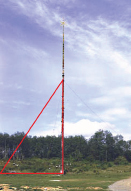
Photo copyright SFU Museum of Archaeology & Ethnology. Used with permission.
A radio transmission tower is supported by a series of guy wires. One such wire is attached to the ground 10 m away from the foot of the tower. How long is the guy wire if it makes a 50° angle with the ground? Round to one decimal place.
View the animated “Guy Wire Solution.”
Did You Know?
The ancient Greeks used the word theamata instead of the word wonders. Theamata means “things to be seen.” Like the Mayan pyramids or the Inca city of Machu Pichu, the pyramids are one of the world’s wonders to be seen!
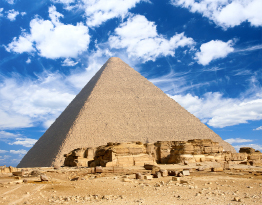
© Maksym Gorpenyuk/shutterstock
Example 2
The Great Pyramid of Khufu at Giza was built more than 4500 years ago. Of the seven wonders of the ancient world, this pyramid is the only one still standing. It stands on a square base with a side length of approximately 230 m. The shortest distance from the apex of the pyramid to the ground along a slanted face of the pyramid is 186 m. That is, the slant height of the pyramid as measured along the middle of a face is 186 m. At what angle is the slant face inclined to the horizontal? Round to the nearest tenth of a degree.
Solution
Draw a diagram.
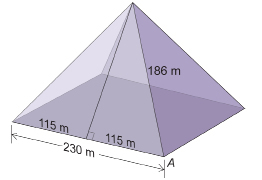
The cross-sectional view of the pyramid can be split into two right triangles, each with a base of 115 m. The base of the pyramid = 2 × base of each right triangle; 230 m = 2 × 115 m.
Let ∠A be the angle of elevation.
Substitute into the formula.
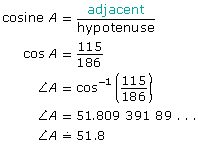
The slant side is inclined at 51.8° to the horizontal.
Example 3
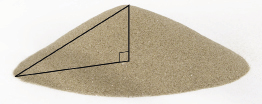
© vita khorzhevska/shutterstock
A conical pile of dry sand has a slant side 2 m in length. If the angle the conical surface makes with the ground is 31°, what is the radius of the pile? Round to one decimal place.
Solution
Draw a diagram.

Let x be the length of the radius.
Substitute into the formula.
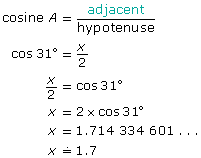
The radius of the sand pile is approximately 1.7 m.
It is your turn to practise these skills!